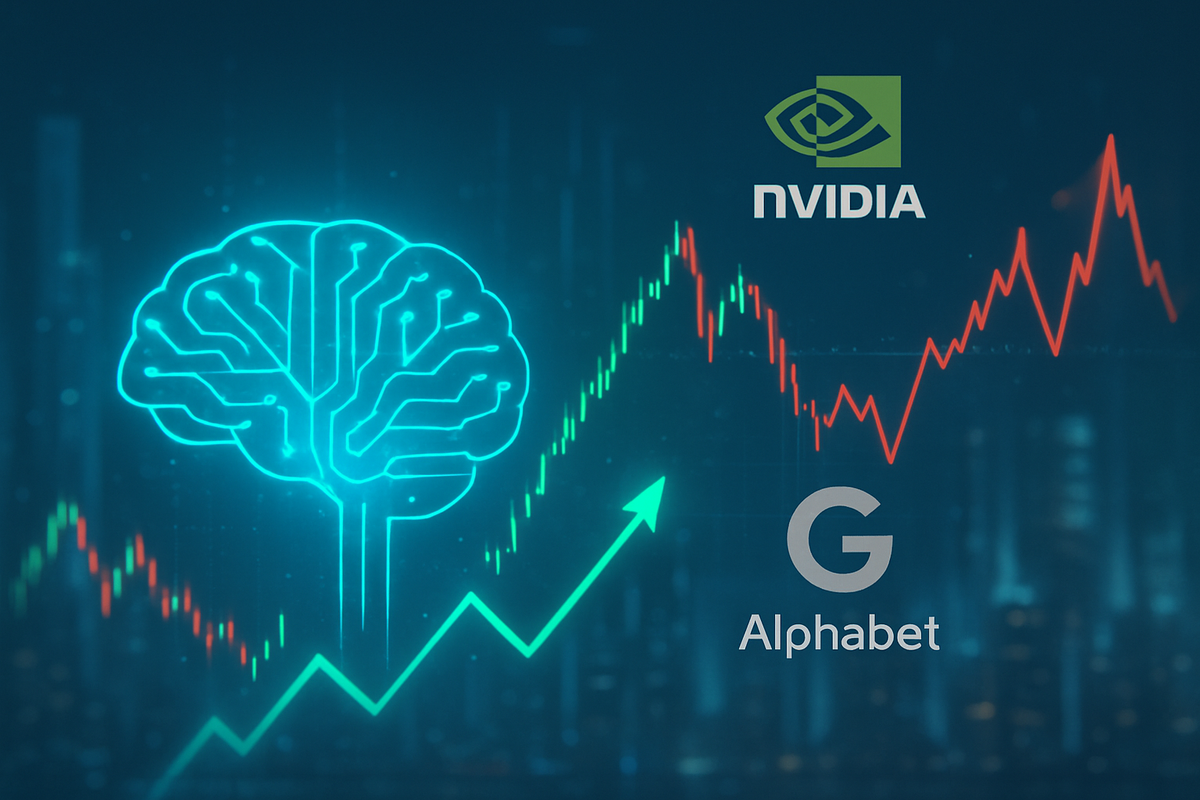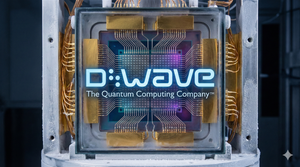
The Artificial Intelligence (AI) sector is currently experiencing significant volatility, marked by a broader tech downturn, investor concerns over stretched valuations, and fears of a potential "AI bubble." Amidst this turbulent landscape, NVIDIA (NASDAQ: NVDA) has largely demonstrated sustained growth, reinforcing its indispensable role in the AI revolution. In stark contrast, tech giant Alphabet (NASDAQ: GOOGL) has faced struggles, caught in a broader market retreat fueled by anxieties surrounding AI valuations and macroeconomic headwinds. This divergence highlights a critical juncture for the AI market, where foundational technology providers continue to thrive while broader application and platform companies face increased scrutiny.
AI's Turbulent Day: Bubble Fears and Market Corrections
The immediate implications of the AI sector's volatility are a palpable sense of caution among investors, leading to notable declines in global stock markets. Both the tech-heavy Nasdaq Composite and the S&P 500 experienced their largest one-day percentage drops in nearly a month in early November 2025. The widespread sell-off in semiconductor stocks, a crucial component of the AI infrastructure, has erased approximately $500 billion in market value, driven by concerns over inflated valuations. Analysts at major financial institutions like Morgan Stanley and Goldman Sachs have contributed to these concerns by suggesting that the AI market might be in bubble territory.
Several factors are fueling this market unease. A significant portion of institutional investors, specifically 54% in an October 2025 Bank of America survey, believe that AI stocks are in a bubble. The Bank of England's Financial Policy Committee has also warned that equity market valuations, particularly for AI-focused technology companies, appear stretched. Adding to the apprehension, weaker-than-expected forecasts from some AI-related companies, such as Palantir Technologies (NYSE: PLTR) and Advanced Micro Devices (NASDAQ: AMD), have dampened investor sentiment. Prominent investors like Michael Burry have also disclosed bearish positions against major AI players, further unsettling the market.
Broader macroeconomic anxieties, including a slowing U.S. economy and a weakening job market, are contributing to the "risk-off" sentiment and impacting high-valuation stocks. While the immediate market reaction has been severe, some analysts view this pullback as a healthy correction, allowing overheated valuations to cool while maintaining optimism for the long-term growth prospects of the AI sector. The current date is November 6, 2025, and these events have unfolded in the immediate past, highlighting real-time market reactions.
Divergent Fortunes: NVIDIA's Ascendance vs. Alphabet's Scrutiny
The current AI sector is experiencing significant volatility, marked by a palpable "risk-off" sentiment among investors who are scrutinizing elevated valuations and raising concerns about a potential "AI bubble." Despite this apprehension, the underlying demand for AI infrastructure remains robust, creating a bifurcated market with distinct winners and losers.
NVIDIA (NASDAQ: NVDA) has emerged as a clear leader and a symbol of resilience amidst AI market volatility. Its dominant position as a foundational infrastructure provider for the AI era has shielded it from much of the downturn affecting other tech stocks. Financially, NVIDIA reported a record $30.0 billion in revenue for Q2 2025, a 122% year-over-year surge, primarily driven by its Data Center segment. This segment, fueled by its Blackwell GPU line, accounted for 88% of total revenue. The company maintains high gross margins, reaching 75.1% GAAP in Q2 2025. Its market capitalization has soared past $5 trillion, making it the first publicly traded company to reach this milestone, with the stock up nearly 50% in 2025. Strategically, NVIDIA's competitive advantage stems from its comprehensive stack of solutions across processors, networking, and software (CUDA), which locks in customers including major cloud service providers and AI model builders. While U.S. export controls have impacted its growth in China, NVIDIA is actively diversifying its business model and deepening ties with other regions and partners.
In contrast, Alphabet (NASDAQ: GOOGL), while often highlighted for "struggles" in the context of intense AI competition and significant investment, has also shown robust growth fueled by AI. The perceived "struggles" often relate to the immense capital expenditures required and the challenge of maintaining its market-leading position. Financially, Alphabet delivered strong Q1 2025 results, reporting consolidated revenues of $90.2 billion, a 12% year-over-year growth, with operating income surging 20% to $30.6 billion. Google Cloud is a significant growth driver, with revenues increasing 28% to $12.3 billion in Q1 2025, and 34% year-over-year to over $15 billion in Q3 2025. The company is significantly increasing its capital expenditures for AI infrastructure, with projections rising to between $91 billion and $93 billion for the year, focused on data centers and custom chips (Tensor Processing Units or TPUs). Strategically, Alphabet is rapidly integrating its flagship AI model, Gemini, into Search and other key products, and Google Cloud is actively competing with Amazon Web Services (NASDAQ: AMZN) and Microsoft Azure (NASDAQ: MSFT), securing major deals with AI startups.
Beyond these giants, other companies are also feeling the effects. Winners include semiconductor manufacturing powerhouses like Taiwan Semiconductor Manufacturing Co. (NYSE: TSM), which produces the high-performance chips for NVIDIA and others. Data center infrastructure providers such as Vertiv Holdings Co. (NYSE: VRT), which supplies thermal systems and liquid cooling, are also benefiting from the unprecedented data center growth. Cloud computing giants Amazon (NASDAQ: AMZN) and Microsoft (NASDAQ: MSFT) are significant beneficiaries due to their extensive cloud platforms and AI integration. Losers in this volatile environment include pure-play AI companies with unproven business models, lacking diversified revenue streams, or merely "AI-washing" their services. Early-stage AI startups face a tougher funding environment, with venture capitalists demanding stronger fundamentals. Companies without a clear "AI growth story" or those with extreme valuations, even some established players like Palantir Technologies (NYSE: PLTR) (trading at over 700 times forward earnings despite strong results), face scrutiny as analysts question the sustainability of "explosive, sustained growth."
Beyond the Hype: The Broader Implications of AI's Volatility
The current volatility in the AI sector, coupled with growing concerns about an "AI bubble," draws parallels to historical tech booms while also exhibiting unique characteristics. This period of intense investor interest and rapid technological advancement carries wider implications for industry trends, competitive landscapes, regulatory frameworks, and economic stability.
The volatility is largely driven by a perceived disconnect between the sky-high valuations of many AI companies and their actual revenue generation and profitability. Concerns include extreme price-to-earnings (P/E) ratios, in some cases reaching 700x for individual companies like Palantir Technologies (NYSE: PLTR), and revenue-loss ratios exceeding 300% for leading AI platforms. For instance, OpenAI, despite a valuation surging to $340 billion by early 2025, is projected to incur significant losses, not expecting profitability until 2029. This speculative excess is fueled by a rapid influx of capital, with AI-related capital expenditures surpassing the U.S. consumer as the primary driver of economic growth in the first half of 2025, accounting for 1.1% of GDP growth. Market concentration risks are also significant, with companies like NVIDIA (NASDAQ: NVDA), which briefly reached a $5 trillion valuation in November 2025, representing approximately 8% of the entire S&P 500 index. This unprecedented concentration could amplify market volatility if institutional investors simultaneously reassess AI sector allocations.
This market landscape fits into a broader trend of technological disruption and its economic consequences, representing a significant shift in capital allocation towards sectors perceived as future-proof. The AI boom is considered a foundational technological shift, impacting every layer of the tech stack and economy, rather than just a fleeting theme. Unlike previous cycles, major players driving AI development are predominantly established technology companies such as Microsoft (NASDAQ: MSFT), Google (NASDAQ: GOOGL), Amazon (NASDAQ: AMZN), and NVIDIA (NASDAQ: NVDA), which possess diversified revenue streams and substantial cash reserves. This integrated approach suggests a more robust and sustainable research and development ecosystem compared to previous bubble periods.
The volatility and "AI bubble" concerns are creating significant ripple effects across the industry. The emergence of competitive, low-cost open-source AI models, such as DeepSeek R1 from China, intensifies global technological competition and can trigger market plunges for established players. The immense capital expenditure required for AI infrastructure is redefining power dynamics, particularly in cloud computing, leading to a consolidation of compute capacity around a few large providers. Smaller AI startups, especially those simply "wrapping" existing large language models, face the risk of being "steamrolled" by foundation model providers. The rapid growth and concentration in the AI sector are also drawing increased scrutiny from regulators globally, raising concerns about market concentration, antitrust issues, financial market stability (especially with AI-driven trading), data privacy, algorithmic bias, and systemic risk. Central banks, like the Federal Reserve, face increased complexity in managing economic stability amidst these rapid technological shifts.
The current AI boom is frequently compared to the dot-com bubble of the late 1990s and early 2000s, showing both striking similarities and crucial differences. Similarities include rapid valuation increases, speculative investment, widespread enthusiasm for transformative technology, and a focus on potential rather than immediate financial fundamentals. However, key differences exist: many leading AI companies today are established tech giants with strong existing revenue streams, unlike the startup-dominated dot-com bubble. The current capital environment is arguably more rational, with significant direct involvement of tech giants, which could act as a buffer against a dramatic market crash. AI is also seen as a more foundational technological shift with broader economic impact. There is also a greater awareness among investors and industry leaders of potential bubble patterns this time, with prominent figures cautioning against AI euphoria.
The Road Ahead: Navigating AI's Evolving Landscape
The artificial intelligence (AI) sector is currently navigating a period of significant volatility, prompting discussions about a potential "AI bubble" akin to past tech booms. While the industry undeniably holds immense transformative potential, concerns are mounting over stretched valuations and the sustainability of current growth trajectories. The future of AI will be shaped by how companies, markets, and governments adapt to these challenges and capitalize on emerging opportunities in both the short and long term.
In the immediate future (next 6-12 months), the AI sector is expected to remain dynamic and potentially volatile. There will be a crucial market recalibration, shifting focus from speculative enthusiasm to the demand for tangible returns and robust business models. Companies will face increasing pressure to demonstrate clear Return on Investment (ROI) from their generative AI (GenAI) deployments. A notable short-term trend is the accelerated adoption of "agentic AI," where enterprises move beyond experimental phases to strategically deploy AI systems that can proactively pursue goals and generate solutions. The cost bottleneck for AI adoption is also expected to ease, with inference costs declining significantly, making AI more accessible. The labor market will likely experience more concrete AI-driven job displacement, particularly in roles involving repetitive tasks, though new AI-related jobs are also expected to emerge.
Looking further ahead, AI is projected to become a fundamental, general-purpose technology, driving widespread adoption and significant productivity enhancements across nearly all sectors. This will lead to profound societal changes, including an increased "tempo of life" and broad efficiency gains across industries like education, healthcare, finance, law, and transportation. Agentic AI systems are expected to become central to managing business workflows and smart homes. The primary AI computing workload will shift from training complex models to deploying them for inference, and the emergence of "Edge AI" and "Sovereign AI" are expected to drive further massive growth in the semiconductor market. McKinsey estimates that AI could add $13 trillion to the global economy by 2030. However, long-term challenges include concerns about AI developing independent thought, potential existential risks, and the predicted exhaustion of human-generated data for training large AI models by 2026, necessitating a shift towards synthetic data.
In this volatile environment, companies will need to make strategic pivots. This includes a renewed focus on fundamentals and value, prioritizing businesses with robust fundamentals, diversified portfolios, high gross margins, intellectual property, and pricing power. Strategic AI deployment, moving beyond mere experimentation to practical applications that create competitive advantages and measurable ROI, will be crucial. Implementing systematic, transparent approaches to AI governance, risk management, and ethical practices will be essential for building trust and ensuring sustained value. Companies must also build resilience and adaptability by investing in redundant infrastructure, localized production, diversified supply chains, and decentralized decision-making. Workforce transformation through proactive reskilling will be necessary to prepare for new AI-related jobs and manage job displacement.
Emerging markets also stand at a crossroads, where AI can either accelerate development or deepen existing disparities. Opportunities include the chance to "leapfrog" traditional development stages, accelerating economic and social progress in sectors like financial services, e-commerce, healthcare, and agriculture. However, significant challenges exist, such as a lack of reliable internet access, inadequate digital infrastructure, limited access to technology, and a persistent AI talent gap. Potential scenarios for the AI industry range from a utopian future with transformative scientific breakthroughs and seamless integration across all business models, to a more gradual but promising progress, or an unevenly distributed future where benefits are concentrated. A market correction and consolidation, potentially mirroring the dot-com bust, could occur if the bold promises of AI do not materialize, leading to consolidation and weeding out unsustainable ventures.
Investing in the Future: Key Takeaways and Watchpoints
The AI sector has experienced significant volatility in 2025, following a period of impressive growth in 2023 and 2024. This fluctuating environment presents both challenges and opportunities for investors. The recent volatility in the AI sector stems from a confluence of factors, including the revaluation of AI companies due to concerns about inflated valuations not always substantiated by traditional financial fundamentals. Intense competition, a shifting geopolitical policy landscape (e.g., chip export restrictions), and a narrow rally concentrated in a handful of mega-cap AI-focused businesses further contribute to market uncertainty. Concerns also exist around "circular financing arrangements" where AI companies invest in or purchase services from each other, potentially obscuring genuine market demand.
Despite the recent turbulence, the long-term outlook for the AI market remains robust and transformative. Projections indicate a remarkable expansion, with the global AI market anticipated to become a multi-trillion-dollar economy by 2030, growing at a compound annual growth rate (CAGR) of 29.20% from 2025 to 2032. Generative AI is a particularly fast-growing segment, with a projected CAGR of 34.5% over the forecast period, and its market size is expected to reach $220 billion by 2030. Key sectors attracting substantial AI investment include healthcare, financial technology for fraud detection and automated trading, autonomous vehicles, and enterprise software solutions. Governments worldwide are also prioritizing and committing significant resources to AI research, development, and infrastructure.
The volatility in the AI sector underscores its profound and lasting impact across industries. AI is not merely a technological advancement but a fundamental force reshaping entire value chains, driving efficiency, reducing costs, and spurring innovation. However, this transformative power also brings new risks. The increasing adoption of AI in financial markets, particularly through high-frequency and algorithmic trading, could lead to both greater efficiency and increased market volatility. The significant computational demands of AI development are also raising concerns about global energy supply, with data center electricity consumption projected to rise dramatically.
Given the dynamic nature of the AI sector, investors should remain vigilant and adopt a strategic approach. Key watchpoints for the coming months include:
- Focus on Fundamentals: Prioritize companies with strong underlying financials, clear strategic rationales, and proven ability to generate returns on investment from scaled AI applications.
- Monitor Valuations: Be wary of companies trading at excessively high multiples unsupported by actual earnings or robust growth projections.
- Track AI Adoption and Deployment: Observe the practical integration and effectiveness of AI across various industries.
- Assess Macroeconomic Factors: Keep a close eye on global economic conditions, inflation dynamics, interest rate policies, and potential changes in tariffs.
- Diversify Portfolios: Avoid overconcentration in a narrow band of mega-cap AI stocks.
- Watch for Geopolitical Developments: Geopolitical tensions can significantly impact supply chains (e.g., semiconductor chips) and create uncertainty.
- Consider Energy Supply: The immense power demands of AI data centers mean that developments in energy supply and infrastructure will be crucial.
- Beware of "Circular" Financing: Be cautious of investment relationships within the AI sector that appear to generate artificial revenue streams.
By maintaining a long-term perspective and focusing on robust fundamentals, diversified exposure, and critical market indicators, investors can better navigate the evolving landscape of AI sector volatility.
This content is intended for informational purposes only and is not financial advice







